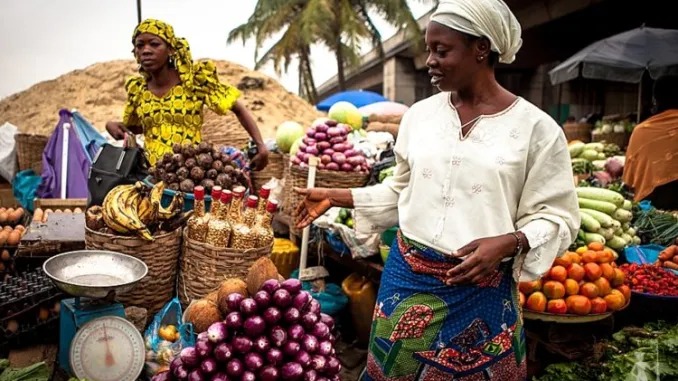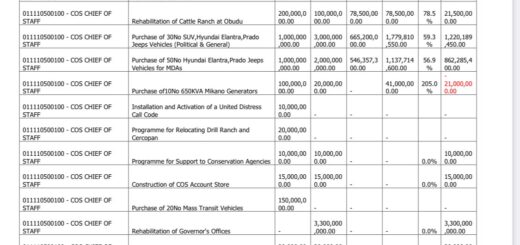Why prices of food items’ll soar higher — Investigation
 WE don’t tell people about prices of tomatoes and pepper again because they may fluctuate at any time. Sometimes, we sell at a particular price in the morning and by noon or evening, the price changes.”
WE don’t tell people about prices of tomatoes and pepper again because they may fluctuate at any time. Sometimes, we sell at a particular price in the morning and by noon or evening, the price changes.”
This was how Mrs Hannatu Ajiji, an official at the Tomatoes/pepper Market along Bauchi Ring Road, Jos, Plateau State, captured the surge in prices of foodstuffs in the country.
The trend is making it difficult for most Nigerians to feed as their purchasing power continues to dwindle.
Various reasons, ranging from the high cost of transportation, increasing inability of farmers to go to farms due to insecurity, foreign exchange, climate change effects, multiple taxation, late release of budget allocation; and rising inflation, among others, have been fingered for the soaring prices of food items.
Disturbed by the development, some experts, and leading lawyer, Dr Olisa Agbakoba, SAN, have tasked governments on action to fight hunger and avert looming hunger riots.
Indeed, the House of Representatives urged the Federal Government to collaborate with state governments to address the current food insecurity in the nation through a mechanized agricultural revolution.
NBS data
The National Bureau of Statistics, NBS, in its Selected Food Prices Watch (May 2024) disclosed that the average price of 1kg local rice stood at N1,608.89, indicating a rise of 189.79 per cent in price on a year-on-year basis from N555.18 recorded in May 2023 and a 14.98 per cent rise in price on a month-on-month basis from N1,399.34 in April 2024.
The average price of 1kg of brown beans increased by 219.05 per cent year-on-year from N629.75 in May 2023 to N2,009.23 in May 2024.
On a month-on-month basis, the average price of this item increased by 44.77 per cent from N1,387.90 in April 2024.
The average price of 1kg of tomatoes rose by 196.92 per cent on a year-on-year basis from N498.34 in May 2023 to N 1,479.69 in May 2024. On a month-on-month basis, it increased by 31.71 per cent from N1,123.41 in April 2024.
Related News
Vanguard @40: The inside story, by the ‘home battalion’
Bi-Courtney debunks ticket racketeering allegation at MMA2
Benue court remands 5 for kidnap, murder, rape, robbery
Furthermore, the average price of 1kg of white Garri rose by 200.12% on a year-on-year basis from N371.42 in May 2023 to N1,114.72 in May 2024, while there was an increase of 30.87% on a month-on-month basis.
Also, the average price of 1kg of Yam tuber increased by 189.20% on a year-on-year basis from N457.25 in May 2023 to N1,322.36 in May 2024. On a month-on-month basis, it increased by 16.98% from N1,130.37 in April 2024.
Why yams are expensive
The Benue State Chairman of the National Association of Yam Farmers, Processors and Marketers, NAYFPM, Mr Dominic Osoh, blamed the rising prices of yam tubers on the high cost of transportation.
Osoh said, “The transportation fare we pay to move yam from the village to the market is not helping the situation. The amount we pay to move a pick-up load of yams from the villages to the city market has tripled because of the increase in the price of fuel which has also forced farmers and traders to increase the price of one tuber of yam.
“The rising prices of herbicides and pesticides have also contributed to the increase in prices of yam. We also have the issue of insecurity. The attack on rural farmers by armed herdsmen and bandits is affecting yam production because when farmers do not feel safe to go to the farm, the implication is a shortage or a drop in the quantity of yam produced, leading to high prices.”
Mr Bitrus Dacha, chairman of Muundip Yam Zone, Gidan Dabat in Qua’an Pan LGA of Plateau State, explained thus: “Yam is very costly because yam availability is at its last lap now and the new ones are not yet out and coupled with the harsh economy.
“A big tuber of yam goes for N5,000. Meanwhile, the smaller yam seed for planting is now N250. If you need a medium size, up to 100 pieces, it is N350,000 naira to N400,000 naira.”
A yam dealer at the Yandoya market, Gangare, Jos, Alhaji Isa Magaji, said yams are costly because “no yams are coming into the market. This is not the season for yams, and yams are perishable, so the stored yams that we sell have almost finished.
Traders lament
A trader in Dakwo Market, Abuja Municipal Area Council, AMAC, Federal Capital Territory, Ebube Linhard, said a measure of a plastic basket of tomatoes now sells for N20,000, against the previous price of N4,000, and pepper of the same measurement sells for N20,000 currently.
Linhard said: “The cost of a measurement for a plastic basket is now sold at N20,000, and pepper goes for N20,000. The big, weaved tomato basket is sold for N100,000.”
At Federal Old Secretariat Market in Area I, Garki, Abuja, a fruit and vegetable seller, Maria David, recalled how they used to buy and sell tomatoes and pepper before the prices of both commodities hit the roof.
“Before, we used to sell a measurement of tomatoes in plastic baskets (the type used for refuse collection in offices) for N5,000, but now we are selling it for N15,000, N20,000, and N25,000, depending on the grade of tomato.
“For the big basket of tomatoes, we sell for N70,000, N100,000, and N120,000, depending on the grade of tomato. While for small measurements in little bowls go for N1,000 and N2,000 respectively,” David said.
High transportation cost
David continued: “The cost of transportation is very high and adversely contributes to the high cost of tomatoes and pepper. Insecurity also contributes greatly to the problem.
“We used to hire vehicles at N7,000 or N10,000 to convey our produce from Mararaba, Nasarawa State, and Zuba, a boundary town with Niger State to our market here in Area I, Garki Old Secretariat. Now we spend over N20,000.
At Kabusa Market in Abuja Municipal Area Council, AMAC, a measurement of a plastic basket goes for N14,000, while pepper with the same measure sells for N15,000. A bag of rice is sold at between N75,000 and N85,000, while yam is sold at N30,000 for 10 tubers of yam.
An official at the Tomatoes/pepper market along the Bauchi Ring Road, Jos, Plateau state, Hannatu Ajiji said: “We don’t tell people about prices of tomatoes and pepper again because they may fluctuate at any time. Sometimes we sell at a particular price in the morning and by noon or evening, the price changes.
“As one comes into the market, you buy at the selling price for that time. For instance, tomatoes have been selling for between N12,000, N13,000, and N15,000, but today, they are sold for N23,000 and N25,000. The price may be reduced or increased before the day ends.
“This is not our fault; we consider the expected quantity of the produce that will come into the market. Remember, the farmers are being challenged by insecurity, the high cost of chemicals, transportation, and other factors. If the cost of everything is high, tomatoes and peppers can not be cheap.”
The Sokoto situation
Checks at Ramen Kura vegetables and yam market in Sokoto revealed that a tuber of yam which was sold for N1,300 is now sold for N5,000, which goes beyond the reach of an average salary earner.
A sack of dried pepper (tattasai) is now sold for N76,000 to N80,000, against its former price of N25,000 in January and February.
A basket of fresh tomatoes (Kwando), which was formerly sold for N5,000 to N10,000, is now sold for between N30,000 and N35,000 to wholesale buyers who, in turn, sell to retailers with a profit margin.
Dangerous trend
The most dangerous trend is the price of traditional staple foodstuffs in the state, such as guinea corn and millet.
Alhaji Yusuf Mai Ata, chairman of Sokoto vegetables market, attributed the current upsurge in prices of tomatoes, pepper and other vegetables to transportation and the rising cost of fertilizer which now sells at N40,000, against its former price of N15,000 early this year.
In Calabar, Cross River State, Mrs Modupe Ogundipe, who buys tomatoes and pepper in bags, baskets and sells them at the popular Watt Market, said the availability of the produce is one challenge, while transportation is another factor which has led to the increase.
She told Vanguard that a basket of tomatoes that used to sell for N70,000 is now N150,000 and a small basket they used to buy from Cameroon for N7,000 now costs N26,000 to N28,000 and before it gets to them in Calabar it will be about N33,000.
At Popular Itam Market in Uyo, Joyce Okon, a bulk purchaser and seller of tomato and pepper said: “The ‘sugar bag’ (100kg) of pepper now sells between N200,000 and N250,000. The sugar sack contains four paint buckets. It’s becoming difficult to remain in business.
“For tomatoes, we have not been getting the big baskets to buy for some time. It takes three small baskets to fill the popular big size. Just a week ago, we were getting a small tomato basket for N18,000.
“But two days ago, when we received supplies, they sold the same for N21,000. That was an evening purchase. If I had gone in the day, it would have been up to N23,000.
“So as we go to retail in the market, customers are complaining bitterly, but we are not being wicked. We want to sell and make turnover as quickly as possible because it is from selling we fend for our families.”
Unbearable, choking prices
Arit Mmakamba trades in yams at the same Itam market. She buys from Ogoja in Cross River State. She said the choking prices were induced more by the cost of transportation.
“A tuber of yam now lands and sells at between N900 and N4,500, depending on the size. It is not our making. We pray the economy improves so the prices will drop from these unbearable rates.”
Abubakar, a tomato seller at the popular Bodija market in Ibadan, explained to Vanguard: “Tomato prices have tripled in the last month. It’s not just the rains damaging crops; we also have problems with transportation costs.
At the popular Mile 12 market in Lagos, the prices of perishable and non-perishable food items have soared by over 300 per cent.
A 50kg basket of tomatoes which was sold for N35,000 in 2023 has risen to N100,000 and the price of a 50kg bag of Scotch Bonnet, popularly known as rodo or ata rodo pepper jumped by over 600 per cent to N120,000.
Similarly, a 50kg basket of bell pepper, also called tatashe rose to N95,000 from N21,000, while the same quantity of red chilli pepper, also known as Bawa or shombo rose to N110,000.
A trader, who identified herself as Iya Olabisi, said the high cost had to do with the transportation of the products from the northern parts of the country and Benin Republic to Lagos.
Reprieve in Katsina
However, in Katsina State, residents are enjoying a reprieve from high food prices with a significant drop in the cost of some essential items after the Eid al-Adha (Sallah) celebrations. This decline is likely due to the drop in buying pressure experienced before and during Sallah.
Vanguard’s checks showed that the price of a large basket of tomatoes, which soared to N130,000 during Sallah, has now fallen by almost half to N70,000.
Similarly, the cost of tatashe pepper has seen a slight decrease with a bag known locally as Buhun solo now selling for N110,000, compared to N120,000 during the festive period.
Onions have also seen a modest reduction, with a 100kg bag dropping from N40,000 to N36,000.
However, the price of yams appear to be the only exception to this downward trend with a rise to N500,000 per 100 tubers compared to N400,000 during Sallah.
Experts proffer solutions
The Chief Executive Officer, CEO, EA Daniels Farm, Sapele, Delta State, Engr Daniel Ijeh, said: “The major problems that led to high food prices include insecurity, poor yields of our crops, heat also affected the crops, and the issue of middlemen who dictate prices of foodstuffs, and farmers don’t have a say over that because farmers don’t have direct access to markets where they can sell their farm produce.
“Poor storage facilities for grains is another challenge because the storage facilities are not functioning optimally, and whenever we are off-peak period, nothing cushions the effects, which if we have enough production we can push to storage, especially this period that grain in the market has reduced we can bring out and supply the ones in the silos.”
On what the government can do to address issues driving high food prices he said: “One, insecurity is still there and the government needs to tackle that. Two, build the capacity of farmers on climate change issues as it affects food production because climate varies in the northern and southern parts of the country. Third, state and local governments’ attention should be drawn, the farmers are there, and they should be committed to the farmers and food production by rolling out interventions. ‘’They should look at corporate farms, facilitate loans, and other incentives for farmers because the Federal Government does not have much say in food production.
“The Bank of Agriculture, BoA, should step in by providing technology and mechanisation for farmers, and there could be a subsidy for drones for spraying, smaller tractors, we are not looking for John Deere tractors but small tractors that are around N4 million or N5 million which are locally manufactured and are efficient.
The National President, Smallholder Women Farmers Organizations in Nigeria, SWOFON, Fatima Gunmi, said women farmers need serious support to address high food prices.
“Smallholder Women Farmers Organizations in Nigeria, SWOFON, are yet to benefit from government interventions. Therefore, they want to call on the government to come to the aid of SWOFON so as to improve their livelihoods and contribute to food security in the country. SWOFON are in the 36 states and FCT with local government branches,’’ Gunmi added.
Multiple taxes, illegal levies
The Benue State Chairman, National Association of Yam Farmers, Processors and Marketers, NAYFPM, Mr. Dominic Osoh, attributed the rising cost to multiple taxation.
He said: “I want to state clearly that the cause of the rising prices of yams in a state like Benue that is the home of yams, can be blamed on some factors and one of them is multiple taxes that we pay from the point of production to take the product to the market.
“In the markets, we pay unnecessary taxes, usually imposed by persons who do not have the support of the government. They bring several papers demanding that we pay illegal levies and taxes before we sell the yam in the market, which obviously will be added to the price we eventually sell the produce.
“We appeal to the governor to intervene and ensure that incidents of multiple and illegal taxes and levies going on in our rural communities and markets are tackled headlong.”
Foreign exchange quagmire
One of the biggest rice dealers in Calabar, Mazi Ikechukwu Udensi, who owns an outlet at Etim Edem Street, said he now sells both local and foreign rice for between N65,000 and N85,000 per bag.
While noting that the rise in the price of foreign rice is due to transportation, he noted that foreign exchange is also a problem
Alhaji Musa, an importer based in Ibadan, said: “The value of the naira has dropped against the dollar, which means we have to spend more to bring rice into the country.”
The Vice President of All Farmers Association of Nigeria, AFAN, Chief Daniel Okafor, said the basic issues around the high cost of tomato, pepper and rice, which make Nigerians groan, “boil down to insecurity, ravaging most of our farms and farmers’ efforts.
“How can they risk their lives and go and sell at a loss to whoever wants to buy the tomato or pepper from them? So, this fact is a major cause of the high prices of tomatoes and pepper in the market.’’
Late release of budgetary allocations
“Another reason there is this astronomical increase in prices on tomato and pepper is the late signing of and release of the budget by the government. This is affecting the productivity of farmers.
‘’Look at it. The budget for agriculture has not been released up till now. If the budget is released, the farmers should monitor it because nothing gets to the farmers, not even a farm input.
“Also, the issue of climate change remains a big challenge that is yet to be addressed, and the farmers planting these commodities do not understand how climate change is impacting their crops.”
‘’We call on relevant authorities to ensure they come up with technologies and innovations to boost farmers’ productivity.
Protest looms over hunger, Agbakoba warns
Speaking on the issue, Dr Olisa Agbakoba, SAN, yesterday warned that the food crisis in the country might soon lead to what he described as hunger riots in Nigeria, calling on the Federal Government to act fast.
Agbakoba, disclosed this while addressing newsmen in his office in Ikoyi, Lagos, said majority of Nigerians can no longer put food on their tables due to extreme poverty.
This, he said, has occurred despite the nation’s enormous oil and gas resources which, according to him, have been hijacked by foreigners.
Agbakoba maintained that Nigeria as a nation, should avoid a situation where the masses would be pushed to the point of taking to the streets as a result of hunger.
He noted that hungry people could resort to entering people’s houses and shops in broad daylight to cart away food items.
“Hunger riot can occur anytime in Nigeria,” Agbakoba said, advising Tinubu to restructure his cabinet and cut the cost of governance.
“President Tinubu needs to dismantle the cabinet. Having over 40 ministers is too large. We don’t need more than 20 ministries,” he said.
The legal practitioner advised Tinubu to scrap some taxes.
“Don’t increase taxes, just expand the tax net and go after defaulting IOCs,” he said.
States need to get involved in reducing high food prices – FG
Efforts to reach the Minister of Agriculture and Food Security, Sen Abubakar Kyari, on what the federal government is doing to address the situation were not successful as he was said to be out of the country on official assignments.
However, one of his principal aides who does not want his name mentioned, said: “Food production to reduce high food prices is not exclusively for the Federal Government to do because agriculture is on the concurrent list of the constitution, which the states also have the responsibility to ramp up food production.
‘’Therefore, states have their role to play in ensuring food prices are reduced based on the farms and farmers in their states.
‘’So the factors responsible for the skyrocketing food find prices are not to be traced to the Federal Government alone but the states as well because they have their role to play in the agricultural sector of the economy.’













